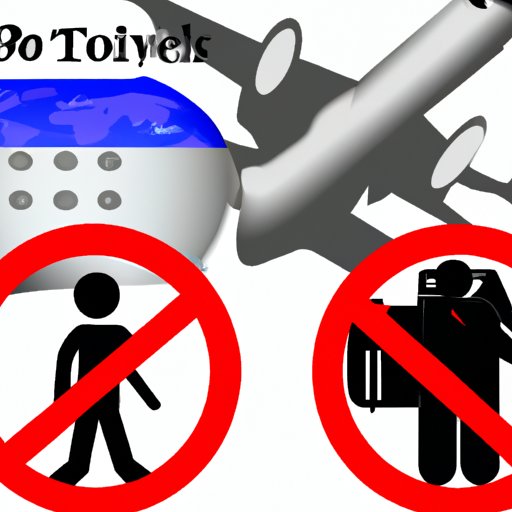Introduction
Travel restrictions are measures imposed by governments to limit or control the movement of people across borders. These measures can range from complete bans on international travel, to more lenient regulations such as bans on travelers from certain countries, mandatory quarantines, or temperature checks. As the COVID-19 pandemic continues to spread, many countries have implemented travel restrictions in an effort to contain the virus.
At the time of writing, the U.S. has banned most non-essential travel from several European countries, the UK, Brazil, China, and India. Other countries have implemented similar measures, including Canada, Australia, and New Zealand. While some countries have begun to relax their restrictions, others remain in place. This raises the question of whether or not travel restrictions will come back.
Impact of Travel Restrictions on the Economy
The economic impact of travel restrictions is significant. The global tourism industry is estimated to have lost over $1 trillion in 2020 due to travel restrictions. Businesses that rely on tourism, such as hotels, restaurants, and transportation providers, have been particularly hard hit. In addition, individuals who work in the tourism sector have seen their jobs disappear or become less secure due to the restrictions.
The effects of travel restrictions are not limited to the tourism industry. Businesses that depend on international trade have also been affected, as the restrictions make it more difficult for companies to transport goods across borders. Furthermore, travelers who were planning to attend conferences, meetings, or other events have had to cancel their plans, which has had a negative impact on businesses that host these events.
Examining the Pros and Cons of Re-Instating Travel Restrictions
Reinstating travel restrictions could have both positive and negative implications. On the one hand, it could help to contain the spread of the virus by limiting the number of people travelling between countries. It could also provide governments with additional resources to implement new health protocols, such as temperature checks and mandatory quarantines.
On the other hand, there are potential drawbacks to re-instating travel restrictions. For example, it could further damage the already struggling global economy by further limiting international trade and tourism. Additionally, it could lead to increased feelings of isolation and anxiety among those unable to travel.

Exploring the Potential Health Benefits of Keeping Travel Restrictions in Place
Keeping travel restrictions in place could offer certain health benefits. Limiting the number of people travelling between countries can help to reduce the spread of infectious diseases, such as COVID-19. It can also help to control the spread of new variants of the virus, which have been found to be more transmissible and potentially more dangerous than the original strain.
In addition, keeping travel restrictions in place could help to prevent the emergence of “super-spreader” events, which occur when a large number of people are infected in a single location. By limiting the number of people travelling, the chances of such an event occurring are reduced.

What Scientists Say About When Travel Restrictions May Be Lifted
Scientists have suggested that several factors should be taken into consideration when determining when to lift travel restrictions. These include the overall rate of infections in a given country, the availability of vaccines, and the efficacy of the vaccines in preventing transmission. Additionally, countries should consider the prevalence of new variants of the virus and the risk of them spreading to other countries.
In general, scientists agree that travel restrictions should only be lifted once the risk of infection has been significantly reduced. This may take some time, as many countries are still struggling to contain the virus. However, once the risk of infection has been reduced, countries may begin to gradually relax their travel restrictions.
How Countries Are Preparing for the Possibility of Travel Restrictions Returning
In preparation for the possibility of travel restrictions returning, many countries have implemented new health protocols. These include temperature checks, mandatory quarantines, and contact tracing. Additionally, some countries are requiring travelers to present proof of a negative COVID-19 test prior to entry. These measures are intended to reduce the risk of infection and prevent the spread of the virus.

Understanding the Political and Social Implications of Reinstating Travel Restrictions
Reinstating travel restrictions could have significant political and social implications. Politically, countries may find themselves in conflict with other nations if they choose to reinstate restrictions unilaterally. For example, the U.S. recently implemented travel restrictions on travelers from Europe, angering many European countries in the process.
Socially, travel restrictions could lead to increased feelings of isolation and anxiety among those unable to travel. This could be particularly true for people living in rural areas or isolated communities, who may feel even more isolated due to the restrictions.
Conclusion
Travel restrictions have had a significant impact on the global economy and have led to increased feelings of isolation and anxiety among those unable to travel. While there are potential benefits to re-instating travel restrictions, such as containing the spread of the virus, there are also potential drawbacks, such as further damaging the global economy. Ultimately, the decision to re-instate travel restrictions should be based on careful consideration of the potential health, economic, political, and social implications.
In order to determine when to lift travel restrictions, countries should consider factors such as the rate of infections, the availability and efficacy of vaccines, and the prevalence of new variants. Additionally, countries should prepare for the possibility of travel restrictions returning by implementing new health protocols and quarantine measures.
(Note: Is this article not meeting your expectations? Do you have knowledge or insights to share? Unlock new opportunities and expand your reach by joining our authors team. Click Registration to join us and share your expertise with our readers.)
